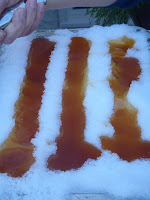Preservation of food has become central to my idea of local cuisine. I've always included meat in my concept of preserving for the impending winter, but I recently realized that this doesn't make much sense.
Before refrigeration, fresh meat could only be kept in the winter. Of course you could kill a chicken in the summer and eat it for dinner, but what if you were to kill a cow and not have a freezer? My great grandparents associated summertime with pickled meat. Butchering was largely done in the colder months, so they were much more likely to enjoy fresh meat in the winter than the summer.
I'm oversimplifying, but you could say that they ate fresh vegetables and pickled meat in the summer, and pickled vegetables and fresh meat in the winter.
This realization turned my idea of winter food on its head, and I started thinking of ways to use the cold weather in cooking. Now and again I'll cool large pots of stock in a snowbank, but there are some preparations that have a more significant dependence on the cold. For instance...
 Maple Taffy
Maple TaffyUsing snow to make candy has been done for centuries in Canada. Toffee, for instance, was invented in Quebec. According to Larousse, a sixteenth century nun set molasses in the snow to attract young natives to her school.
Rapidly cooling sugar syrups helps prevent the growth of crystals, and results in a clear, glassy appearance.
The process is simple enough. Start with maple syrup in a pot over medium heat. The higher the concentration of sugar in a syrup, the higher the temperature at which it boils. The maple syrup will start to boil just above water's boiling point of 212°F. As moisture evaporates and the sugar becomes more concentrated, the temperature of the syrup will rise. The relationship between sugar content and boiling point is direct and predictable: a syrup of 85% sugar will boil at 235°F, a syrup of 90% sugar will boil at 270°F. Candy thermometers are your friends.
Resist the temptation to stir the pot, especially in the later stages of boiling, as you might induce crystalization.
 Heating the syrup to 235°F will yield a sticky, slightly runny though still manageable taffy. I like this stage because it is a little messy. Higher temperatures yield firmer taffies.
Heating the syrup to 235°F will yield a sticky, slightly runny though still manageable taffy. I like this stage because it is a little messy. Higher temperatures yield firmer taffies. As soon as you reach your desired temperature, pour the syrup over clean snow. Wait maybe ten seconds for the syrup to cool, then pick up the taffy by winding it around a popsicle stick or wooden spoon.
Sugar shacks do this in early spring, during the sap run, so that visitors can taste the first syrup of the season. With few hard maples being tapped around Edmonton, this is as much a celebration of the snow as it is the maple. Maybe a good tradition for the first snow fall, rather than the spring.




I love the way you think... you turn me on my head, often!!! I want to have a maple syrup candy making party now!
ReplyDelete